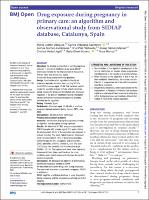| dc.contributor | IDIAP Jordi Gol |
| dc.contributor.author | Lestón Vázquez, Marta |
| dc.contributor.author | Gomez-Lumbreras, Ainhoa |
| dc.contributor.author | Prat Vallverdú, Oriol |
| dc.contributor.author | Giner-Soriano, Maria |
| dc.contributor.author | Morros, Rosa |
| dc.contributor.author | MARSAL MORA, JOSEP RAMON |
| dc.contributor.author | Vilaplana-Carnerero, Carles |
| dc.contributor.author | Vedia Urgell, Cristina |
| dc.date.accessioned | 2023-08-24T07:57:15Z |
| dc.date.available | 2023-08-24T07:57:15Z |
| dc.date.issued | 2023-08-22 |
| dc.identifier.citation | Lestón Vázquez M, Vilaplana-Carnerero C, Gomez-Lumbreras A, Prat-Vallverdu O, Ramon Marsal J, Vedia Urgell C, Soriano, et al. Drug exposure during pregnancy in primary care: an algorithm and observational study from SIDIAP database, Catalunya, Spain. BMJ Open. 2023 Aug 22;13(8):e071335. |
| dc.identifier.issn | 2044-6055 |
| dc.identifier.uri | https://hdl.handle.net/11351/10143 |
| dc.description | Farmacologia clínica; Atenció primària; Medicina reproductiva |
| dc.description.sponsorship | This study received funding from the 8th call for SIDIAP grants, 2018– 2019, expedient number 4R18/188; and from Health Department of the Generalitat de Catalunya, in the call corresponding to 2021 for the granting of funding of the Strategic Plan for Research and Innovation in Health (PERIS) 2021–2024, modality Research Projects in Primary Care, expedient number SLT/21/000068. |
| dc.language.iso | eng |
| dc.publisher | BMJ |
| dc.relation.ispartofseries | BMJ Open;13(8) |
| dc.rights | Attribution-NonCommercial-NoDerivatives 4.0 International |
| dc.rights.uri | http://creativecommons.org/licenses/by-nc-nd/4.0/ |
| dc.source | Scientia |
| dc.subject | Farmacologia clínica |
| dc.subject | Embaràs |
| dc.subject | Salut reproductiva |
| dc.subject | Medicaments - Administració |
| dc.subject.mesh | Pharmacology, Clinical |
| dc.subject.mesh | Pregnancy |
| dc.subject.mesh | Reproductive Health |
| dc.subject.mesh | Prescription Drugs |
| dc.title | Drug exposure during pregnancy in primary care: an algorithm and observational study from SIDIAP database, Catalunya, Spain |
| dc.type | info:eu-repo/semantics/article |
| dc.identifier.doi | 10.1136/ bmjopen-2022-071335 |
| dc.subject.decs | farmacología clínica |
| dc.subject.decs | embarazo |
| dc.subject.decs | salud reproductiva |
| dc.subject.decs | medicamentos por prescripción |
| dc.relation.publishversion | https://doi.org/10.1136/bmjopen-2022-071335 |
| dc.type.version | info:eu-repo/semantics/publishedVersion |
| dc.audience | Professionals |
| dc.contributor.authoraffiliation | [Lestón Vázquez M] Àrea del Medicament i Servei de Farmàcia, Gerència d'Atenció Primària Barcelona Ciutat, Institut Català de la Salut (ICS), Generalitat de Catalunya, Barcelona, Spain. Universitat Autònoma de Barcelona (UAB), Bellaterra (Cerdanyola del Vallès), Spain. [Vilaplana-Carnerero C, Giner-Soriano M, Morros R] Universitat Autònoma de Barcelona (UAB), Bellaterra (Cerdanyola del Vallès), Spain. Fundació Institut Universitari per a la Recerca a l’Atenció Primària de Salut Jordi Gol i Gurina (IDIAPJGol), Barcelona, Spain. [Gomez-Lumbreras A] College of Pharmacy, Department of Pharmacotherapy, University of Utah, Salt Lake City, Utah, USA. [Prat-Vallverdu O] Marketing farmacéutico & Investigación clínica, Barcelona, Spain. Former employee at IDIAPJGol, Barcelona, Spain. [Ramon Marsal J] Former employee at IDIAPJGol, Barcelona, Spain. RTI Health Solutions Barcelona, Barcelona, Spain. [Vedia Urgell C] Universitat Autònoma de Barcelona (UAB), Bellaterra (Cerdanyola del Vallès), Spain. Unitat de farmàcia, Servei d’Atenció Primària Barcelonès Nord i Maresme, Institut Català de la Salut (ICS), Generalitat de Catalunya, Badalona, Spain |
| dc.rights.accessrights | info:eu-repo/semantics/openAccess |

 Àrea privada
Àrea privada Contacte
Contacte







